Improving the Energy Storage of Supercapattery Devices through Electrolyte Optimization for Mg(NbAgS)x(SO4)y Electrode Materials
Abstract
:1. Introduction
2. Experimental Section
2.1. Materials
2.2. Materials Synthesis
2.3. Characterization
2.4. Thermal Calculations
2.5. Viscosity Calculations
2.6. Conductivity Analysis
2.7. Electrochemical Testing
2.8. NMR Calculations
3. Results and Discussion
3.1. Structural Analysis
3.2. Surface Analysis
3.3. FTIR Analysis
3.4. TGA Analysis
3.5. XPS Analysis
3.6. BET Analysis
4. Electrolytic Studies
4.1. Thermal Properties
4.2. Conductivity Analysis
4.3. Viscosity Analysis
4.4. Self-Diffusion Coefficient
4.5. Three-Cell Design
4.6. Two-Cell Design
5. Conclusions
Supplementary Materials
Author Contributions
Funding
Institutional Review Board Statement
Informed Consent Statement
Data Availability Statement
Conflicts of Interest
Sample Availability
References
- Beck, F.; Dolata, M.; Grivei, E.; Probst, N. Electrochemical supercapacitors based on industrial carbon blacks in aqueous H2SO4. J. Appl. Electrochem. 2001, 31, 845–853. [Google Scholar] [CrossRef]
- Tewari, A.; Böhm, S. Graphene based nano-inks for electronic industries. Smart Multifunct. Nano-Inks 2023, 197–226. [Google Scholar] [CrossRef]
- Hassan, H.; Iqbal, M.W.; Gouadria, S.; Afzal, A.M.; Hegazy, H. Zinc Strontium Sulfide@ Carbon nanotube composite electrode materials for high-performance supercapattery devices. J. Mater. Sci. Mater. Electron. 2023, 34, 439. [Google Scholar] [CrossRef]
- Abbas, T.; Iqbal, M.W.; Gouadria, S.; Hegazy, H.H.; Hassan, H.U.; Afzal, A.M.; Aftab, S.; Alzahrani, A. Hydrothermally synthesized highly efficient binary silver strontium sulfide (AgSrS) for high-performance supercapattery applications. J. Solid State Electrochem. 2023, 27, 873–883. [Google Scholar] [CrossRef]
- Yu, L.; Chen, G.Z. Ionic liquid-based electrolytes for supercapacitor and supercapattery. Front. Chem. 2019, 7, 272. [Google Scholar] [CrossRef] [Green Version]
- Iqbal, M.W.; Khan, M.H.; Afzal, A.M.; Hassan, H.; Alzahrani, H.A.; Aftab, S. Incorporation of carbon nanotubes in sulfide-based binary composite to enhance the storage performance of supercapattery devices. J. Appl. Electrochem. 2023, 53, 949–962. [Google Scholar] [CrossRef]
- Zaka, A.; Iqbal, M.W.; Afzal, A.M.; Hassan, H.; Alzahrani, H.A.; Yasmeen, A.; Abbas, T.; Aftab, S.; Neffati, R. Facile synthesis of strontium copper phosphate (SrCuPO4) binary composite for the high-performance supercapattery devices. J. Mater. Sci. Mater. Electron. 2022, 33, 27002–27013. [Google Scholar] [CrossRef]
- Ding, Z.; Xu, X.; Li, J.; Li, Y.; Wang, K.; Lu, T.; Hossain, M.S.A.; Amin, M.A.; Zhang, S.; Pan, L. Nanoarchitectonics from 2D to 3D: MXenes-derived nitrogen-doped 3D nanofibrous architecture for extraordinarily-fast capacitive deionization. Chem. Eng. J. 2022, 430, 133161. [Google Scholar] [CrossRef]
- Kouchahcvili, L.; Entchev, E. Supercapacitors with Extended Operating Potential Window; Materials Science Forum; Trans Tech Publ.: Bäch, Switzerland, 2020; pp. 84–88. [Google Scholar]
- Mousavi, M.P.; Wilson, B.E.; Kashefolgheta, S.; Anderson, E.L.; He, S.; Bühlmann, P.; Stein, A. Ionic liquids as electrolytes for electrochemical double-layer capacitors: Structures that optimize specific energy. ACS Appl. Mater. Interfaces 2016, 8, 3396–3406. [Google Scholar] [CrossRef] [Green Version]
- Newell, R.; Faure-Vincent, J.; Iliev, B.; Schubert, T.; Aradilla, D. A new high performance ionic liquid mixture electrolyte for large temperature range supercapacitor applications (−70 °C to 80 °C) operating at 3.5 V cell voltage. Electrochim. Acta 2018, 267, 15–19. [Google Scholar] [CrossRef]
- Lin, R.; Taberna, P.-L.; Fantini, S.; Presser, V.; Pérez, C.R.; Malbosc, F.; Rupesinghe, N.L.; Teo, K.B.; Gogotsi, Y.; Simon, P. Capacitive energy storage from− 50 to 100 C using an ionic liquid electrolyte. J. Phys. Chem. Lett. 2011, 2, 2396–2401. [Google Scholar] [CrossRef] [Green Version]
- Qu, Q.; Zhang, P.; Wang, B.; Chen, Y.; Tian, S.; Wu, Y.; Holze, R. Electrochemical Performance of MnO2 Nanorods in Neutral Aqueous Electrolytes as a Cathode for Asymmetric Supercapacitors. J. Phys. Chem. C 2009, 113, 14020–14027. [Google Scholar] [CrossRef]
- Hassan, H.; Iqbal, M.W.; Afzal, A.M.; Asghar, M.; Aftab, S. Enhanced the performance of zinc strontium sulfide-based supercapattery device with the polyaniline doped activated carbon. J. Solid State Electrochem. 2023, 27, 125–137. [Google Scholar] [CrossRef]
- Sathiya, M.; Prakash, A.; Ramesha, K.; Tarascon, J.M.; Shukla, A.K. V2O5-anchored carbon nanotubes for enhanced electrochemical energy storage. J. Am. Chem. Soc. 2011, 133, 16291–16299. [Google Scholar] [CrossRef] [PubMed]
- Hassan, H.; Iqbal, M.W.; Gouadria, S.; Afzal, A.M.; Hegazy, H. Effect of electrolytic solutions on the electrochemical performance of binder-free VMnS electrode and its applications as an energy storage devices. J. Energy Storage 2023, 66, 107448. [Google Scholar] [CrossRef]
- Zhang, S.; Xu, K.; Jow, T. Enhanced performance of Li-ion cell with LiBF4-PC based electrolyte by addition of small amount of LiBOB. J. Power Sources 2006, 156, 629–633. [Google Scholar] [CrossRef]
- Zhang, S.S.; Xu, K.; Jow, T.R. Study of LiBF4 as an electrolyte salt for a Li-ion battery. J. Electrochem. Soc. 2002, 149, A586. [Google Scholar] [CrossRef]
- Li, J.; Li, Z.; Tang, S.; Hao, J.; Wang, T.; Wang, C.; Pan, L. Improving the sodium storage performance of carbonaceous anode: Synergistic coupling of pore structure and ordered domain engineering. Carbon 2023, 203, 469–478. [Google Scholar] [CrossRef]
- Hong, E.-S.; Okada, S.; Sonoda, T.; Gopukumar, S.; Yamaki, J.-I. Thermal stability of electrolytes with mixtures of LiPF6 and LiBF4 used in lithium-ion cells. J. Electrochem. Soc. 2004, 151, A1836. [Google Scholar] [CrossRef]
- Perricone, E.; Chamas, M.; Leprêtre, J.-C.; Judeinstein, P.; Azais, P.; Raymundo-Pinero, E.; Béguin, F.; Alloin, F. Safe and performant electrolytes for supercapacitor. Investigation of esters/carbonate mixtures. J. Power Source 2013, 239, 217–224. [Google Scholar] [CrossRef]
- Bhat, T.; Patil, P.; Rakhi, R. Recent trends in electrolytes for supercapacitors. J. Energy Storage 2022, 50, 104222. [Google Scholar] [CrossRef]
- Ye, W.; Wang, H.; Ning, J.; Zhong, Y.; Hu, Y. New types of hybrid electrolytes for supercapacitors. J. Energy Chem. 2021, 57, 219–232. [Google Scholar] [CrossRef]
- Kurzweil, P.; Chwistek, M. Electrochemical stability of organic electrolytes in supercapacitors: Spectroscopy and gas analysis of decomposition products. J. Power Sources 2008, 176, 555–567. [Google Scholar] [CrossRef]
- Li, J.; Ding, Z.; Pan, L.; Li, J.; Wang, C.; Wang, G. Facile self-templating synthesis of layered carbon with N, S dual doping for highly efficient sodium storage. Carbon 2021, 173, 31–40. [Google Scholar] [CrossRef]
- Lang, J.; Zhang, X.; Liu, L.; Yang, B.; Yang, J.; Yan, X. Highly enhanced energy density of supercapacitors at extremely low temperatures. J. Power Sources 2019, 423, 271–279. [Google Scholar] [CrossRef]
- Ju, Y.J.; Lien, C.H.; Chang, K.H.; Hu, C.C.; Wong, D.S.H. Deep Eutectic Solvent-based Ionic Liquid Electrolytes for Electrical Double-layer Capacitors. J. Chin. Chem. Soc. 2012, 59, 1280–1287. [Google Scholar] [CrossRef]
- Cheng, X.; Yuan, J.; Hu, J.; Chen, S.; Yan, H.; Yang, W.; Li, W.; Dai, Y. 2.5 V High-Performance Aqueous and Semi-Solid-State Symmetric Supercapacitors Enabled by 3 m Sulfolane-Saturated Aqueous Electrolytes. Energy Technol. 2022, 10, 2200157. [Google Scholar] [CrossRef]
- Perricone, E.; Chamas, M.; Cointeaux, L.; Leprêtre, J.-C.; Judeinstein, P.; Azais, P.; Béguin, F.; Alloin, F. Investigation of methoxypropionitrile as co-solvent for ethylene carbonate based electrolyte in supercapacitors. A safe and wide temperature range electrolyte. Electrochim. Acta 2013, 93, 1–7. [Google Scholar] [CrossRef]
- Ricketts, B.; Ton-That, C. Self-discharge of carbon-based supercapacitors with organic electrolytes. J. Power Sources 2000, 89, 64–69. [Google Scholar] [CrossRef]
- Azaïs, P.; Duclaux, L.; Florian, P.; Massiot, D.; Lillo-Rodenas, M.-A.; Linares-Solano, A.; Peres, J.-P.; Jehoulet, C.; Béguin, F. Causes of supercapacitors ageing in organic electrolyte. J. Power Sources 2007, 171, 1046–1053. [Google Scholar] [CrossRef]
- Ike, I.S.; Sigalas, I.J.; Iyuke, S.E.; Kalu, E.E. The Contributions of Electrolytes in Achieving the Performance Index of Next-Generation Electrochemical Capacitors (ECs). In Electrochemical Devices for Energy Storage Applications; CRC Press: Boca Raton, FL, USA, 2019; pp. 215–248. [Google Scholar]
- Rafique, H.; Iqbal, M.W.; Wabaidur, S.M.; ul Hassan, H.; Afzal, A.M.; Abbas, T.; Habila, M.A.; Elahi, E. The supercapattery designed with a binary composite of niobium silver sulfide (NbAg2S) and activated carbon for enhanced electrochemical performance. RSC Adv. 2023, 13, 12634–12645. [Google Scholar] [CrossRef] [PubMed]
- Hekmat, F.; Shahi, M.; Dubal, D.P.; Shahrokhian, S. Hierarchical nickel–cobalt sulfide/niobium pentoxide decorated green carbon spheres toward efficient energy storage. Sustain. Energy Fuels 2022, 6, 3042–3055. [Google Scholar] [CrossRef]
- Iqbal, M.W.; Faisal, M.M.; ul Hassan, H.; Afzal, A.M.; Aftab, S.; Zahid, T.; ur Rehman, A. Facile hydrothermal synthesis of high-performance binary silver-cobalt-sulfide for supercapattery devices. J. Energy Storage 2022, 52, 104847. [Google Scholar] [CrossRef]
- Hassan, H.U.; Iqbal, M.W.; Afzal, A.M.; Abbas, T.; Zaka, A.; Yasmeen, A.; Noor, N.A.; Aftab, S.; Ullah, H. Highly stable binary composite of nickel silver sulfide (NiAg2S) synthesized using the hydrothermal approach for high-performance supercapattery applications. Int. J. Energy Res. 2022, 46, 11346–11358. [Google Scholar]
- Shaheen Shah, S.; Abu Nayem, S.; Sultana, N.; Saleh Ahammad, A.; Abdul Aziz, M. Preparation of sulfur-doped carbon for supercapacitor applications: A review. ChemSusChem 2022, 15, e202101282. [Google Scholar] [CrossRef]
- Ma, X.; Zhao, L.; Song, X.; Zhao, L.; Yu, Z.; Xiao, Z.; Wang, X.; Li, S.; Cao, Y.; Ning, G. Production of S-doped porous graphene via post-treatment with MgSO4 as sulphur source. Chem. Eng. J. 2019, 359, 801–809. [Google Scholar] [CrossRef]
- Iqbal, M.Z.; Alam, S.; Afzal, A.M.; Iqbal, M.J.; Yaqoob, K.; Kamran, M.A.; Karim, M.R.A.; Alherbi, T. Binary composites of strontium oxide/polyaniline for high performance supercapattery devices. Solid State Ion. 2020, 347, 115276. [Google Scholar] [CrossRef]
- Suarez, P.A.Z.; Selbach, V.M.; Dullius, J.E.L.; Einloft, S.; Piatnicki, C.M.S.; Azambuja, D.S.; de Souza, R.F.; Dupont, J. Enlarged electrochemical window in dialkyl-imidazolium cation based room-temperature air and water-stable molten salts. Electrochim. Acta 1997, 42, 2533–2535. [Google Scholar] [CrossRef]
- Sulaiman, M.; Su, N.C.; Mohamed, N. Sol-gel synthesis and characterization of MgSO4:Mg(NO3)2–Al2O3 composite solid electrolytes. J. New Mater. Electrochem. Syst. 2019, 22, 132–138. [Google Scholar] [CrossRef]
- Li, W.; Wei, X.; Dong, H.; Ou, Y.; Xiao, S.; Yang, Y.; Xiao, P.; Zhang, Y. Colloidal Synthesis of NbS2 Nanosheets: From Large-Area Ultrathin Nanosheets to Hierarchical Structures. Front. Chem. 2020, 8, 189. [Google Scholar] [CrossRef]
- Lawson, A.J.M.R.B. Lattice instabilities in superconducting ternary molybdenum sulfides. [SnMo/sub 5/S/sub 6/, CoMo/sub 3/S/sub 4/, AgMo/sub 4/S/sub 5/, CuMo/sub 4/S/sub 5/, NiMo/sub 3/S/sub 4/]. Mater. Res. Bull. 1972, 7, 773–776. [Google Scholar] [CrossRef]
- Bokuniaeva, A.; Vorokh, A. Estimation of Particle Size Using the Debye Equation and the Scherrer Formula for Polyphasic TiO2 Powder; Journal of Physics: Conference Series; IOP Publishing: Bristol, UK, 2019; p. 012057. [Google Scholar]
- Mariappan, M.; Madhurambal, G.; Ravindran, B.; Mojumdar, S. Thermal, FTIR and microhardness studies of bisthiourea-urea single crystal. J. Therm. Anal. Calorim. 2011, 104, 915–921. [Google Scholar] [CrossRef]
- Wijayati, N.; Lestari, L.R.; Wulandari, L.A.; Mahatmanti, F.W.; Rakainsa, S.K.; Cahyono, E.; Wahab, R.A. Potassium Alum [KAl (SO4)2 12H2O] solid catalyst for effective and selective methoxylation production of alpha-pinene ether products. Heliyon 2021, 7, e06058. [Google Scholar] [CrossRef] [PubMed]
- Ashok, C.; Rao, K.; Chakra, C.; Rao, K. Mgo nanoparticles prepared by microwave-irradiation technique and its seed germination application. Nano Trends A J. Nanotechnol. Appl. 2016, 18, 10–17. [Google Scholar]
- Dai, C.; Zhang, H.; Li, R.; Zou, H. Synthesis and characterization of thiourea. Pol. J. Chem. Technol. 2019, 21, 35–39. [Google Scholar] [CrossRef] [Green Version]
- Mena-Morcillo, E.; Veleva, L. Degradation of AZ31 and AZ91 magnesium alloys in different physiological media: Effect of surface layer stability on electrochemical behaviour. J. Magnes. Alloy. 2020, 8, 667–675. [Google Scholar] [CrossRef]
- Saha, M.; Ghosh, S.; Paul, S.; Dalal, B.; De, S.K. Nb-Dopant-Induced Tuning of Optical and Electrical Property of Anatase TiO2 Nanocrystals. ChemistrySelect 2018, 3, 6654–6664. [Google Scholar] [CrossRef]
- de Paiva, A.B.; Vargas, L.M.B.; da Silva, M.J.; Rodrigues, A.D.G.; Soares, D.A.; Peres, M.L.; de Godoy, M.P.F. The negative photoconductivity of Ag/AgO grown by spray-pyrolysis. Surfaces 2022, 5, 209–217. [Google Scholar] [CrossRef]
- Varodi, C.; Pogăcean, F.; Cioriță, A.; Pană, O.; Leoștean, C.; Cozar, B.; Radu, T.; Coroș, M.; Ștefan-van Staden, R.I.; Pruneanu, S.-M. Nitrogen and sulfur co-doped graphene as efficient electrode material for l-cysteine detection. Chemosensors 2021, 9, 146. [Google Scholar] [CrossRef]
- Li, X.; Liu, L.; Wang, X.; Ok, Y.S.; Elliott, J.A.; Chang, S.X.; Chung, H.-J. Flexible and self-healing aqueous supercapacitors for low temperature applications: Polyampholyte gel electrolytes with biochar electrodes. Sci. Rep. 2017, 7, 1685. [Google Scholar] [CrossRef] [Green Version]
- Cheng, Q.; Tang, J.; Ma, J.; Zhang, H.; Shinya, N.; Qin, L.-C. Graphene and carbon nanotube composite electrodes for supercapacitors with ultra-high energy density. Phys. Chem. Chem. Phys. 2011, 13, 17615–17624. [Google Scholar] [CrossRef] [PubMed]
- Biswal, M.; Banerjee, A.; Deo, M.; Ogale, S. From dead leaves to high energy density supercapacitors. Energy Environ. Sci. 2013, 6, 1249–1259. [Google Scholar] [CrossRef]
- Pour, G.B.; Aval, L.F.; Mirzaee, M. CNTs supercapacitor based on the PVDF/PVA gel electrolytes. Recent Pat. Nanotechnol. 2020, 14, 163–170. [Google Scholar] [CrossRef] [PubMed]
- Kota, M.; Jana, M.; Park, H.S. Improving energy density of supercapacitors using heteroatom-incorporated three-dimensional macro-porous graphene electrodes and organic electrolytes. J. Power Sources 2018, 399, 83–88. [Google Scholar] [CrossRef]
- Liang, Y.; Liang, F.; Zhong, H.; Li, Z.; Fu, R.; Wu, D. An advanced carbonaceous porous network for high-performance organic electrolyte supercapacitors. J. Mater. Chem. A 2013, 1, 7000–7005. [Google Scholar] [CrossRef]
- Liu, P.; Liu, J.; Cheng, S.; Cai, W.; Yu, F.; Zhang, Y.; Wu, P.; Liu, M. A high-performance electrode for supercapacitors: Silver nanoparticles grown on a porous perovskite-type material La0.7Sr0.3CoO3−δ substrate. Chem. Eng. J. 2017, 328, 1–10. [Google Scholar] [CrossRef]
- Kim, B.; Chung, H.; Kim, W. High-performance supercapacitors based on vertically aligned carbon nanotubes and nonaqueous electrolytes. Nanotechnology 2012, 23, 155401. [Google Scholar] [CrossRef]
- Zhang, L.; Zhu, Y.; Zhao, W.; Zhang, L.; Ye, X.; Feng, J.-J. Facile one-step synthesis of three-dimensional freestanding hierarchical porous carbon for high energy density supercapacitors in organic electrolyte. J. Electroanal. Chem. 2018, 818, 51–57. [Google Scholar] [CrossRef]
- Samoc, A. Dispersion of refractive properties of solvents: Chloroform, toluene, benzene, and carbon disulfide in ultraviolet, visible, and near-infrared. J. Appl. Phys. 2003, 94, 6167–6174. [Google Scholar] [CrossRef]
- Speight, J. Lange’s Handbook of Chemistry; McGraw-Hill Education: New York, NY, USA, 2005. [Google Scholar]
- Maryott, A.A.; Smith, E.R. Table of Dielectric Constants of Pure Liquids; US Government Printing Office: Washington, DC, USA, 1951. [Google Scholar]
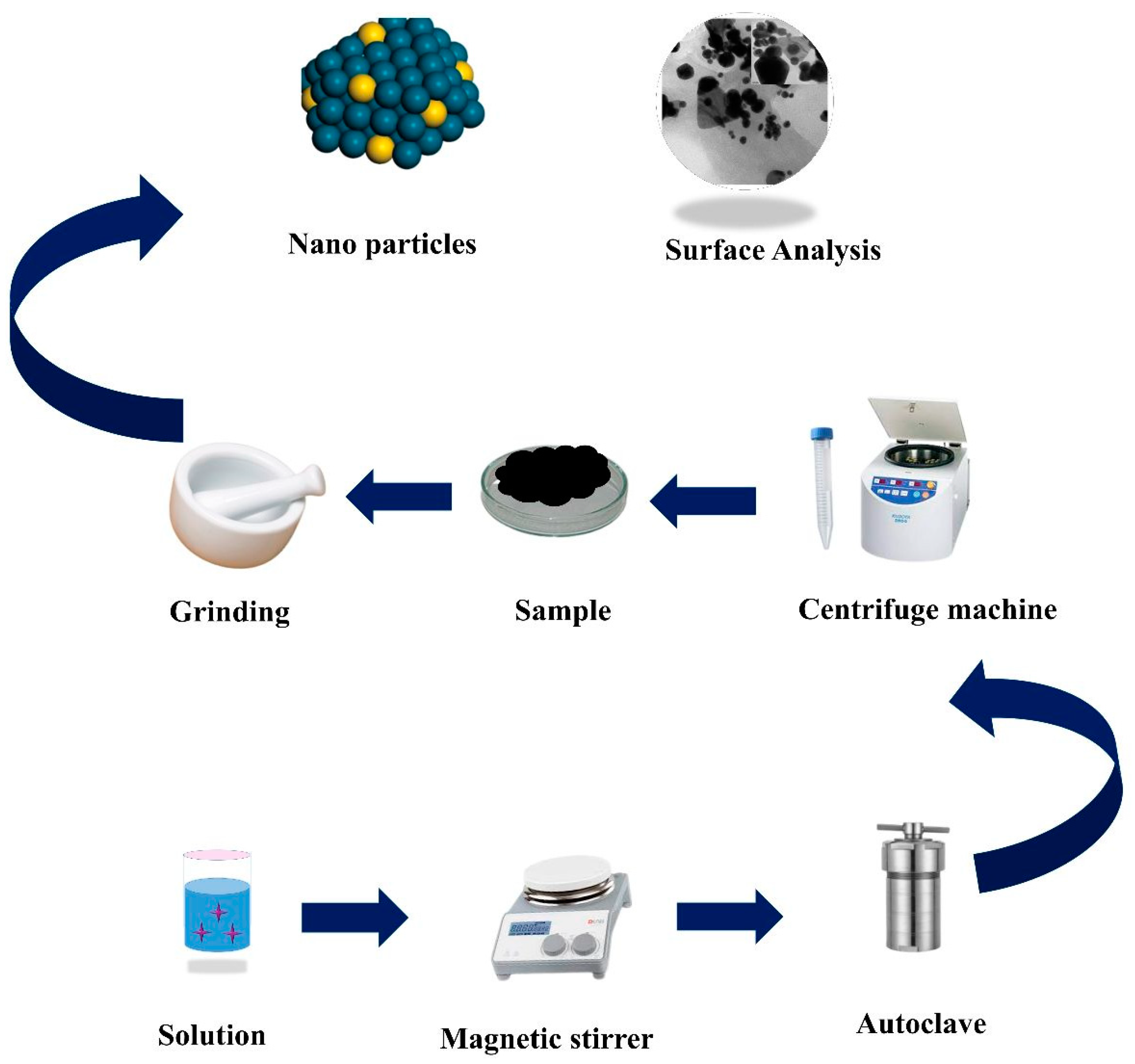

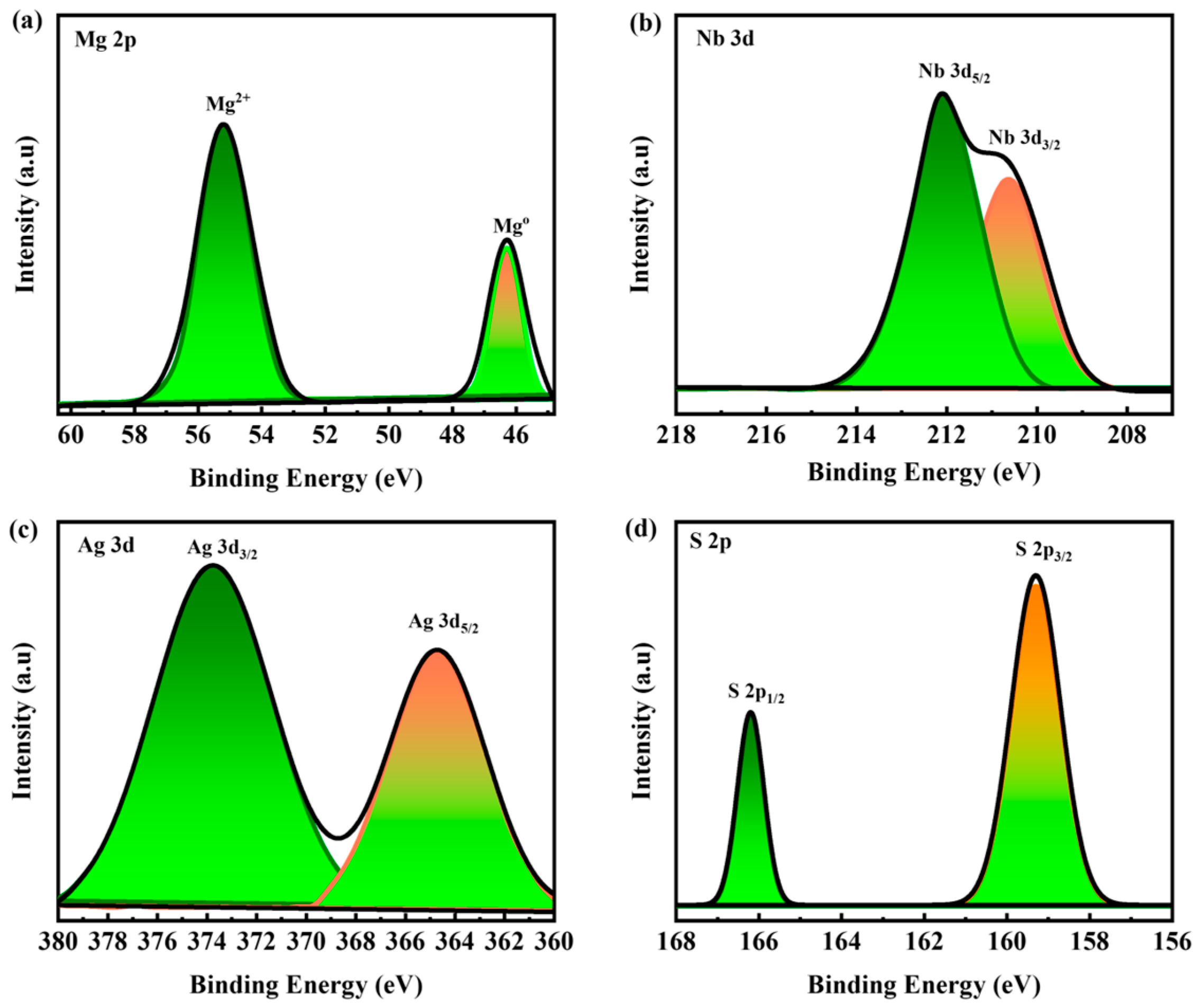
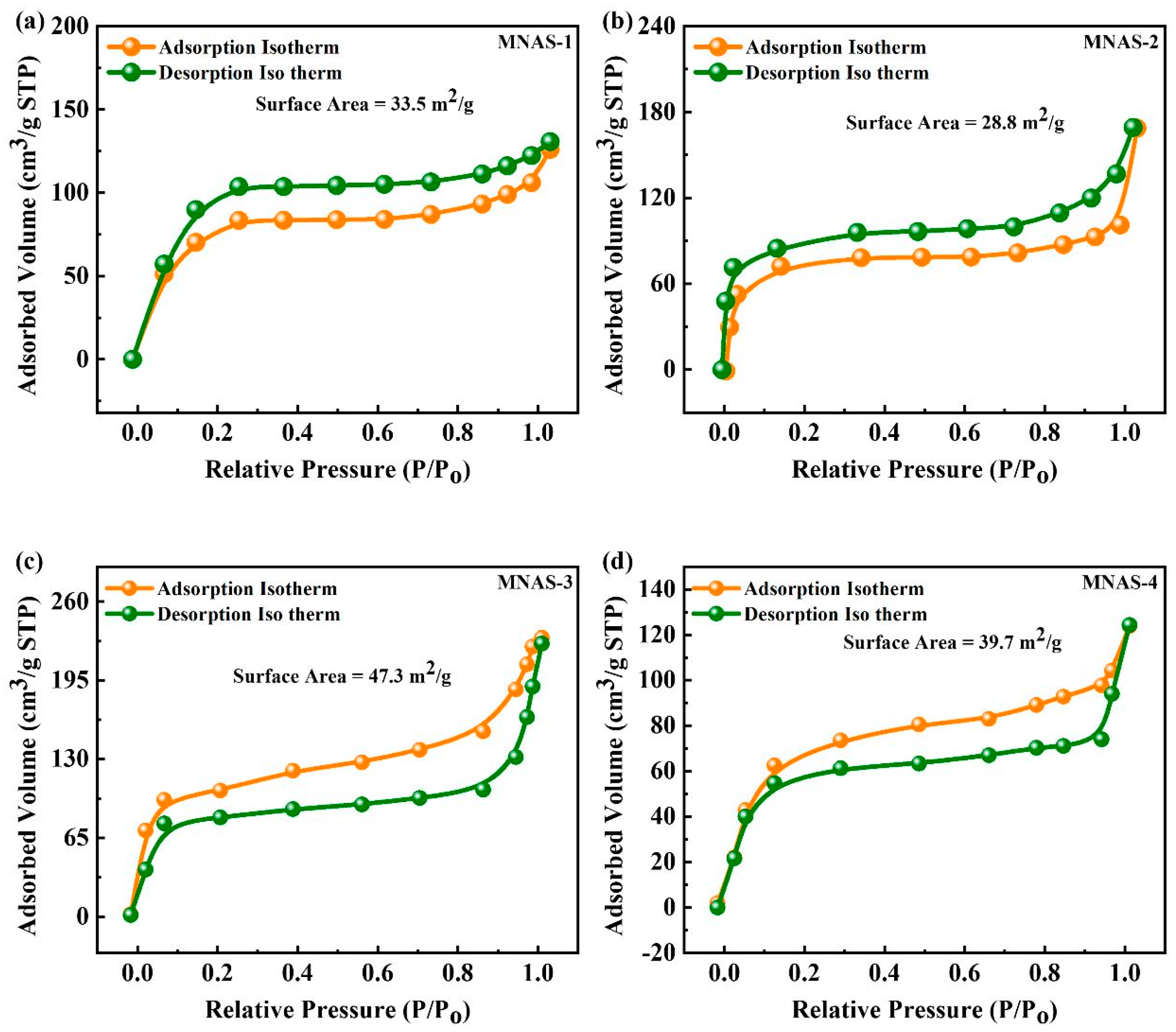


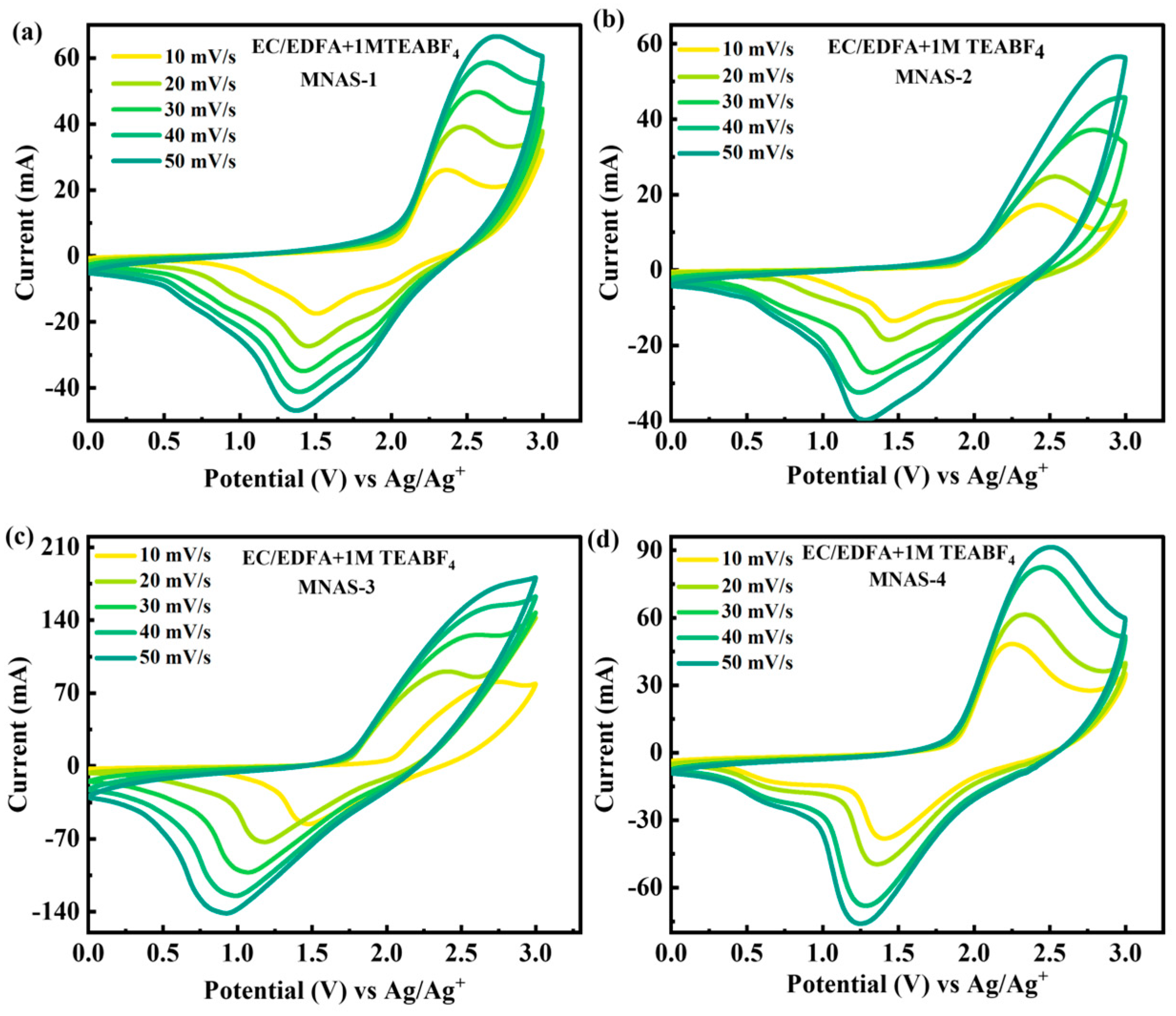
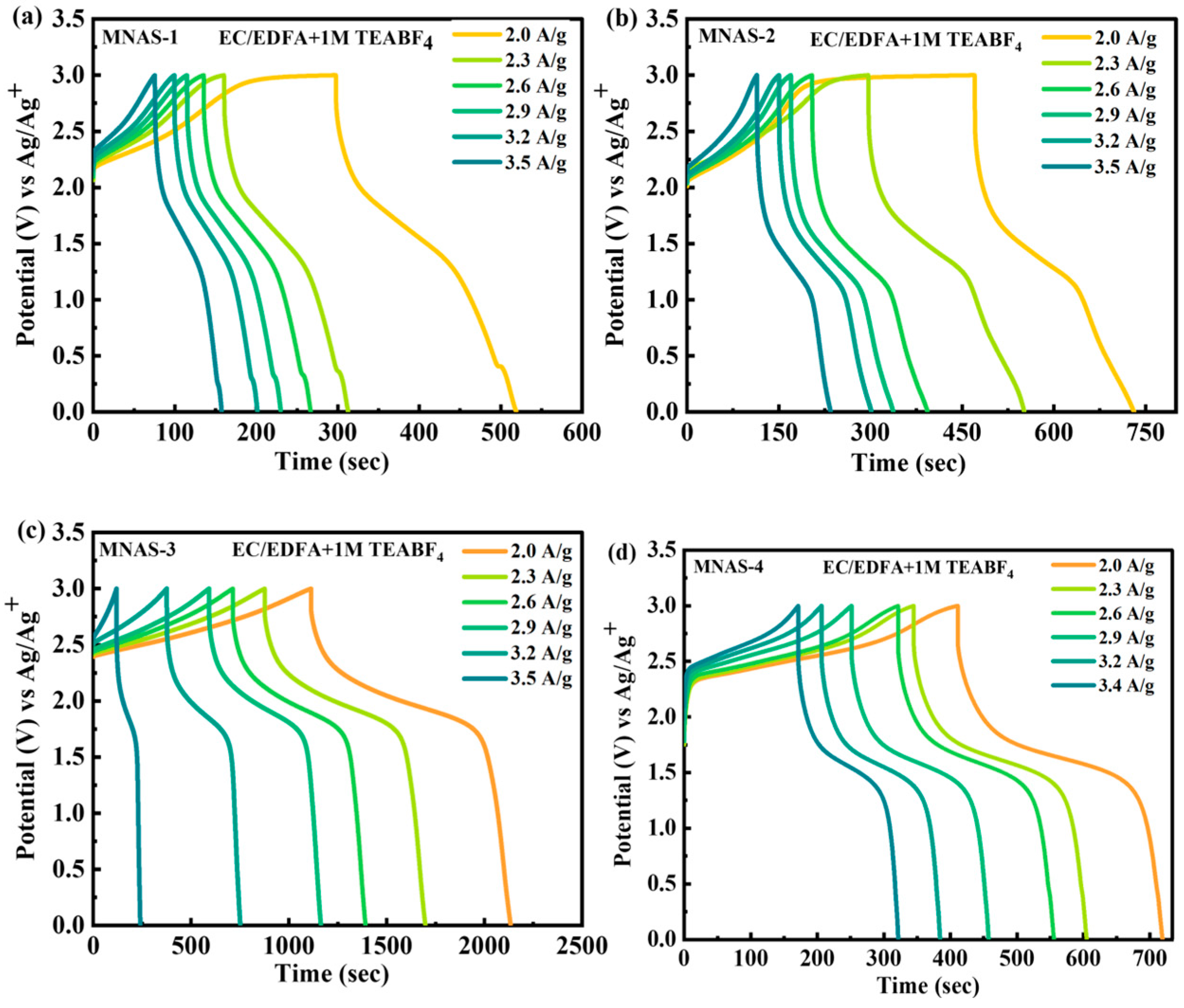
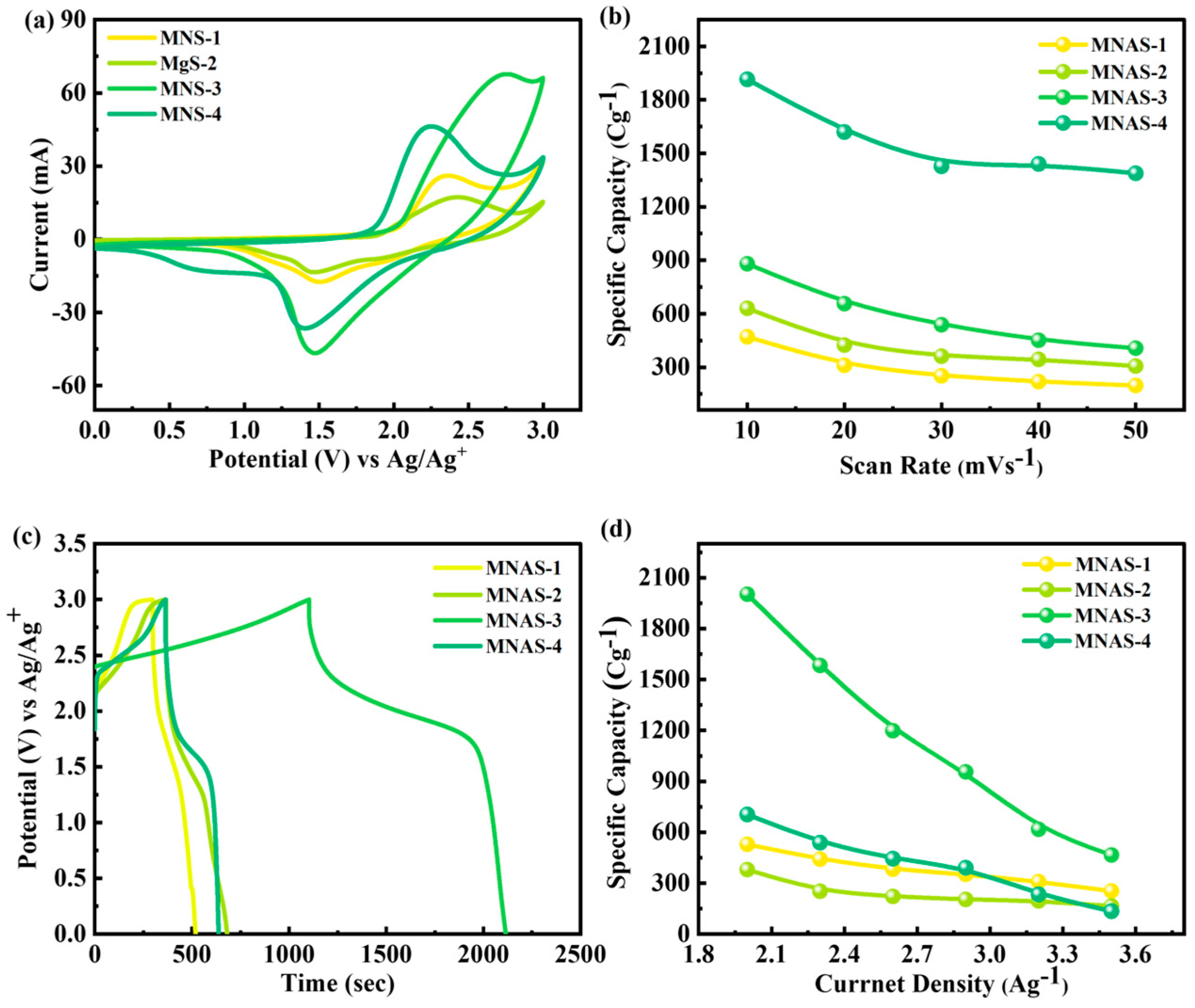
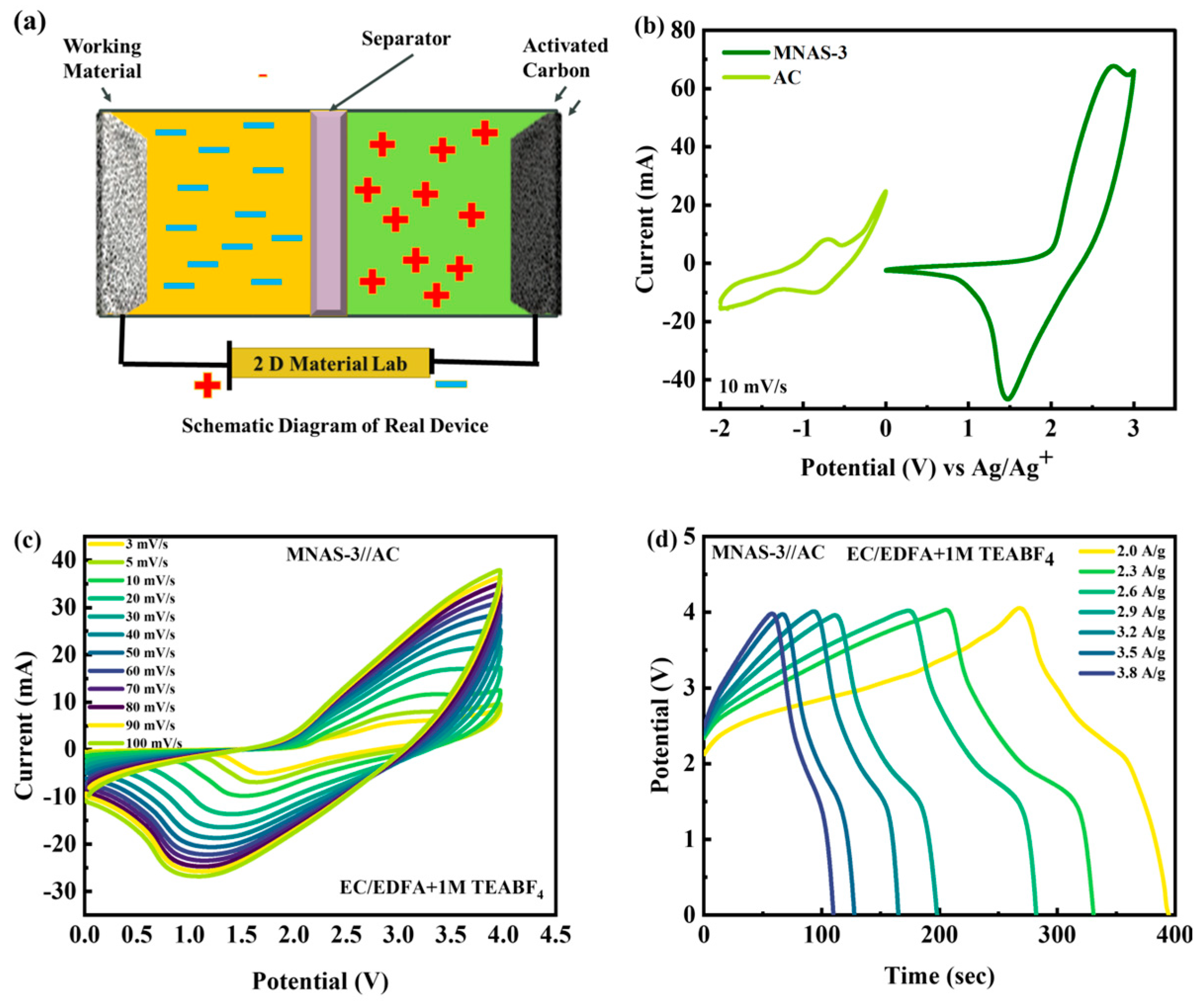
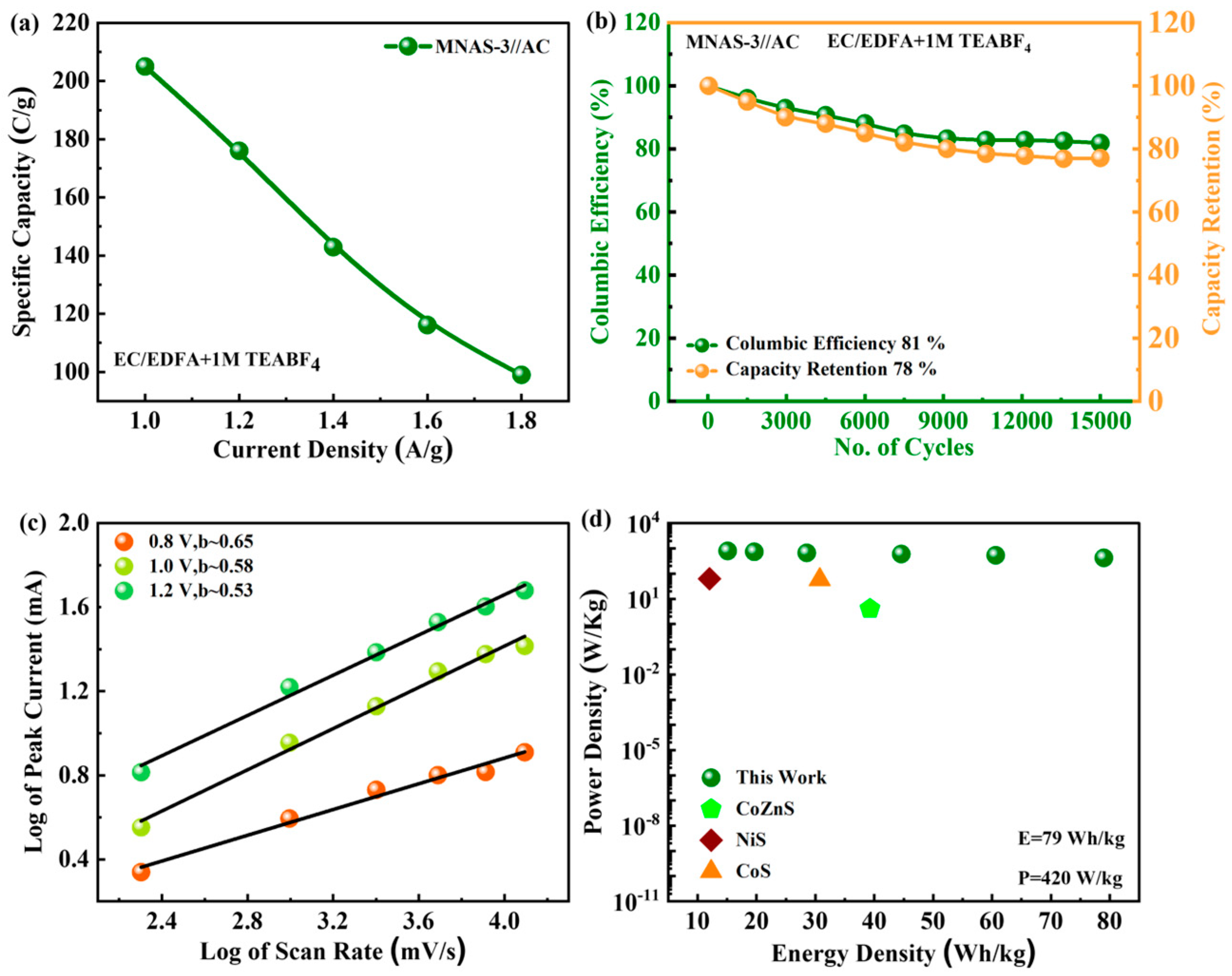
| Materials | SSA (m2/g) | Pore Volume (cm3/g) | Pore Size (nm) |
|---|---|---|---|
| MNAS-1 | 33.5 | 0.023 | 8 |
| MNAS-2 | 28.8 | 0.019 | 11 |
| MNAS-3 | 47.3 | 0.044 | 15 |
| MNAS-4 | 39.7 | 0.037 | 12 |
| Solution | Melting Point (°C) | Crystallization Temperature (°C) |
|---|---|---|
| PC | −49 | −56 |
| EC | 43 | 25 |
| EA | −79 | -- |
| EC/EA (50/50 wt%) | 39 | 27 |
| EC/EDFA | 19 | −5 |
| EC/MMOA | −31 | −65 |
| EC/MPA | 33 | 20 |
| EC in 1 M SBPBF4 | 38 | 15 |
| EC/EA in 1 M SBPBF4 | 14 | −4 |
| EC/MMOA in 1 M SBPBF4 | −53 | −77 |
| EC/EDFA in 1 M SBPBF4 | 3 | −67 |
| Electrolyte Mixture | ||||||||||
|---|---|---|---|---|---|---|---|---|---|---|
| Proportion in Vol% | 100 | 80 | 50 | 20 | 0 | |||||
| SBPBF4/TEABF4 | SBPBF4/TEABF4 | SBPBF4/TEABF4 | SBPBF4/TEABF4 | SBPBF4/TEABF4 | ||||||
| EC/MMOA | 2.75 | 2.6 | 2.48 | 2.35 | 2.14 | 2.07 | 1.78 | 1.32 | 1.64 | 1.43 |
| EC/EA | 2.75 | 2.6 | 2.40 | 2.29 | 1.80 | 1.55 | 1.44 | 1.26 | ------ | |
| EC/EDFA | 2.75 | 2.6 | 2.30 | 2.22 | 1.65 | 1.36 | 1.19 | 1.06 | 1.38 | 1.20 |
| EC/MPA | 2.75 | 2.6 | 2.62 | 2.52 | 2.38 | 2.25 | 1.94 | 1.61 | ----- | |
| Electrolyte | DTEA+106 cm/s | cm/s | DEC+106 cm/s | DMMOA+106 cm/s | T+ | at 40 °C/ms cm−1 | |
|---|---|---|---|---|---|---|---|
| EC | 3.98 | 4.82 | 5.39 | ----- | 0.43 | 23.1 | 0.63 |
| 50 EC + 50 EDFA | 5.23 | 6.90 | 7.33 | 8.32 | 0.48 | 18.7 | 0.45 |
| 80 EC + 20 EDFA | 6.04 | 5.83 | 6.12 | 5.12 | 0.32 | 20.9 | 0.54 |
| Electrode Material | Electrolyte | Specific Capacity | Energy Density (Wh/kg) | Power Density (W/kg) |
|---|---|---|---|---|
| Graphene/SWCNT [54] | Organic | 201 F/g | 62.8 | 58.5 |
| Conducting Carbon produced from dead plants [55] CNT-based Supercapacitor [56] | Organic PVDF/PVA | 88 F/g 173 F/g | 55 ------- | ------ ------ |
| 3D-Graphene electrode [57] | TEABF4 | 23.1 F/g | 20 | 6190 |
| Porous network structured Carbon [58] | Organic | ---------- | 41 | 67 |
| Ag nanoparticles grown on porous perovskite-type material [59] | 1 M KOH | 517.5 F/g | 21.9 | 90.3 |
| Vertically aligned CNT [60] | Ionic | 75 F/g | 27 | 987 |
| 3D porous carbon [61] | Organic | 130 F/g | 55 | 2500 |
| This work | EC/EDFA in 1 M TEABF4 | 208 C/g | 79 | 420 |
Disclaimer/Publisher’s Note: The statements, opinions and data contained in all publications are solely those of the individual author(s) and contributor(s) and not of MDPI and/or the editor(s). MDPI and/or the editor(s) disclaim responsibility for any injury to people or property resulting from any ideas, methods, instructions or products referred to in the content. |
© 2023 by the authors. Licensee MDPI, Basel, Switzerland. This article is an open access article distributed under the terms and conditions of the Creative Commons Attribution (CC BY) license (https://creativecommons.org/licenses/by/4.0/).
Share and Cite
Hassan, H.; Iqbal, M.W.; Alharthi, S.; Amin, M.A.; Afzal, A.M.; Ryl, J.; Ansari, M.Z. Improving the Energy Storage of Supercapattery Devices through Electrolyte Optimization for Mg(NbAgS)x(SO4)y Electrode Materials. Molecules 2023, 28, 4737. https://doi.org/10.3390/molecules28124737
Hassan H, Iqbal MW, Alharthi S, Amin MA, Afzal AM, Ryl J, Ansari MZ. Improving the Energy Storage of Supercapattery Devices through Electrolyte Optimization for Mg(NbAgS)x(SO4)y Electrode Materials. Molecules. 2023; 28(12):4737. https://doi.org/10.3390/molecules28124737
Chicago/Turabian StyleHassan, Haseebul, Muhammad Waqas Iqbal, Sarah Alharthi, Mohammed A. Amin, Amir Muhammad Afzal, Jacek Ryl, and Mohd Zahid Ansari. 2023. "Improving the Energy Storage of Supercapattery Devices through Electrolyte Optimization for Mg(NbAgS)x(SO4)y Electrode Materials" Molecules 28, no. 12: 4737. https://doi.org/10.3390/molecules28124737






